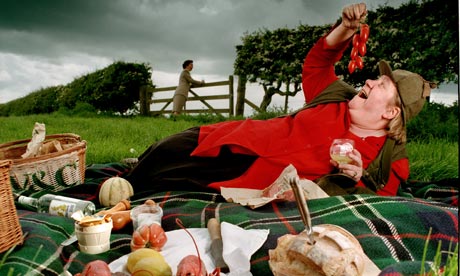
At the end of her new book, Clarissa Dickson Wright describes the meal she would like to eat before "they come to get me" (she doesn't say who "they" are; perhaps she, too, is worried about BBC budget cuts). There will be oyster beignets and freshly cut asparagus, beef consomme and Morecambe Bay shrimps, roast wing of beef and raspberries with pouring cream. Also, a bracing mint sorbet, to be served before the main course. This feast will be cooked for her by Shaun Hill, the chef at the Walnut Tree near Abergavenny, Wales, whose services she has apparently already booked. "It is perhaps rather a rich meal," she concludes. "But in the circumstances, I don't think I will be too concerned."
Dickson Wright is, as this menu reminds you, a slightly unusual combination: as particular as she is greedy. Not for her the outsized bag of Doritos. If she is going to eat meat, for instance, it must be rare breed, properly aged, and served with her beloved cardoons en gratin (she has a "passion" for cardoons). So it's rather odd that her new book, a volume she claims always to have wanted to write, is so flabby and tasteless. Wimping out on facts – she sprinkles the phrases "I'd guess" and "I'd suspect" as merrily as salt, and over every chapter – without ever, quite, daring to turn the whole thing into polemic, it's the prose version of a supermarket chicken, bred so as not to alarm the weedy tastebuds of the masses. If the cover, featuring a smiling Dickson Wright, some Cornishware, and the most horrid and cheesy olde worlde font I've ever seen, shouts: "Christmas is coming! Buy me for your mum!", then the contents murmur: "But if she wants bath salts, I'd do for your auntie or uncle just as well."
She begins her history in the mid-12th century, a relatively peaceful and wealthy time. The Normans have introduced rabbit warrens; people also eat pike, eels, pigeon, deer, and, er, badger. ("West Country pubs of my childhood," writes Dickson Wright, in a typically proprietorial kind of an aside, "had badger hams on the bar rather as a Spanish tapas bar has jamón ibérico.") From here, she goes on to examine the effect of the Crusades (the introduction of spices, rosewater and mint sauce, probably); the invention of breakfast in the 15th century (boiled beef and mutton, salt fish and buttered eggs); the Tudors' love of marzipan (marchpane, as it was known, was modelled into extravagant shapes, such as a deer with an arrow in its side; when the arrow was removed, red wine flowed from the wound); and James II's coronation banquet (puffins were served). It's a straightforward, chronological path, with a few of her memories – ah, the good old charcoal burners who lived in the woods of her childhood – thrown in for those who, like her, never leave the house without their rose-tinted sunglasses.
Naturally, she is devoted to the Georgians, who brought us the kitchen range, ice houses and marmalade, and who treated their overindulgence with the laxative rhubarb. But after this – as she proceeds ever closer to our own time – you can sense her losing heart. Oh, the ghastliness of Mrs Beeton! Oh, the awfulness of a new class who didn't properly know how to run their servants! (In one of her more gruesomely snobbish asides, she notes that Mrs Thatcher, a grocer's daughter, was apt – yikes! – to scrape and stack her own plates, in spite of the waiting Chequers staff.) By the time she reaches the 1950s she seems to run entirely out of steam, dispatching the decade in a lofty: "We were fortunate enough to have a cook in the 1950s. Other people had Marguerite Patten and Constance Spry."
Other people. This, you begin to grasp, is Dickson Wright's major problem with 20th-century life – that and the slow decline of the English pig. On late-20th-century food she is feeble indeed. She praises Delia Smith, Keith Floyd and, more bizarrely, Anthony Worrall Thompson, but cannot be bothered to engage with how and why most of us eat – mostly, I imagine, because she does not know.
Closing the book – it ends with a clutch of ancient recipes, including one for something known as "sweet cubes of jellied milk" – I felt as I used to as child when, arriving home from school, I would discover that the biscuit tin was empty. By which I mean: pretty cross. All of the information in this book can be found elsewhere, and much better done, too. For starters, try Kate Colquhoun's Taste: The Story of Britain Through Its Cooking. If this goes down well, move swiftly on to Dorothy Hartley's classic Food in England, a work of true scholarship that has never been out of print since it was first published in 1954.

